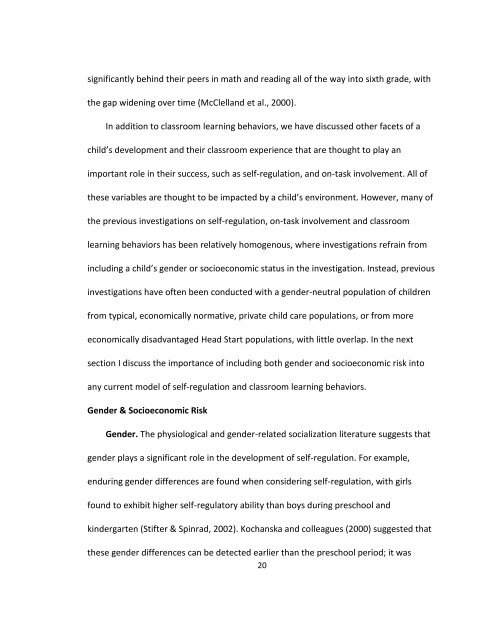SELF-REGULATION, EMOTION EXPRESSION & CLASSROOM ...
SELF-REGULATION, EMOTION EXPRESSION & CLASSROOM ...
SELF-REGULATION, EMOTION EXPRESSION & CLASSROOM ...
You also want an ePaper? Increase the reach of your titles
YUMPU automatically turns print PDFs into web optimized ePapers that Google loves.
significantly behind their peers in math and reading all of the way into sixth grade, with<br />
the gap widening over time (McClelland et al., 2000).<br />
In addition to classroom learning behaviors, we have discussed other facets of a<br />
child’s development and their classroom experience that are thought to play an<br />
important role in their success, such as self-regulation, and on-task involvement. All of<br />
these variables are thought to be impacted by a child’s environment. However, many of<br />
the previous investigations on self-regulation, on-task involvement and classroom<br />
learning behaviors has been relatively homogenous, where investigations refrain from<br />
including a child’s gender or socioeconomic status in the investigation. Instead, previous<br />
investigations have often been conducted with a gender-neutral population of children<br />
from typical, economically normative, private child care populations, or from more<br />
economically disadvantaged Head Start populations, with little overlap. In the next<br />
section I discuss the importance of including both gender and socioeconomic risk into<br />
any current model of self-regulation and classroom learning behaviors.<br />
Gender & Socioeconomic Risk<br />
Gender. The physiological and gender-related socialization literature suggests that<br />
gender plays a significant role in the development of self-regulation. For example,<br />
enduring gender differences are found when considering self-regulation, with girls<br />
found to exhibit higher self-regulatory ability than boys during preschool and<br />
kindergarten (Stifter & Spinrad, 2002). Kochanska and colleagues (2000) suggested that<br />
these gender differences can be detected earlier than the preschool period; it was<br />
20



![[Sample B: Approval/Signature Sheet] - George Mason University](https://img.yumpu.com/21978828/1/190x245/sample-b-approval-signature-sheet-george-mason-university.jpg?quality=85)


![[Sample B: Approval/Signature Sheet] - George Mason University](https://img.yumpu.com/18694905/1/190x245/sample-b-approval-signature-sheet-george-mason-university.jpg?quality=85)






![[Sample B: Approval/Signature Sheet] - George Mason University](https://img.yumpu.com/18694552/1/189x260/sample-b-approval-signature-sheet-george-mason-university.jpg?quality=85)


![[Sample B: Approval/Signature Sheet] - George Mason University](https://img.yumpu.com/18694474/1/190x245/sample-b-approval-signature-sheet-george-mason-university.jpg?quality=85)